The name of this flower is unusual at first glance - heliotrope, but translated from Greek it means “turning after the sun.” Indeed, heliotrope flowers turn their heads towards the sun during the day.There are several subtleties in planting, caring for, and growing heliotrope, which are discussed in our article.
Photo of heliotrope in the garden
| Content:
|
Heliotrope flower
Heliotrope is a representative of the Borage family, which migrated to us from South America and the Mediterranean. Decorative types of heliotrope have the appearance of a small shrub 20-60 cm high.
Heliotrope is notable for its small flowers of white, blue or purple, grouped in lush caps-inflorescences. The inflorescences are located on straight, long peduncles.
Thanks to breeding work, many crop varieties with different flowering periods have been created. You can choose them so that the bushes bloom throughout the season. Heliotrope is a light-loving, heat-loving plant, therefore it is afraid of frost and dies when the temperature drops.
The crop is grown in native climatic conditions as a perennial. In mid-latitudes with frosty winters, growing conditions allow the flower to be cultivated as an annual. Hybrid varieties can be grown in room conditions.
Reproduction methods
Reproduction of heliotrope is a difficult process that requires a lot of attention and effort. Like many plants, heliotrope can be propagated by seeds or cuttings. Both methods contain some difficulties.
In the first case, the difficulty lies in the long period of flower development.
Propagation by cuttings is more suitable for the southern regions of Russia. In regions with cold winters, certain actions will be required to obtain a positive result.
Is it possible to plant heliotrope seeds in open ground?
When growing heliotrope from seeds, flowering occurs 80-110 days after germination. That is why planting heliotrope with seeds in open ground in the short summer conditions of the Central Russian region is not practiced, since flowering will begin in late summer or early autumn.
Seedling growing method
To increase the duration of flowering of a crop, it is more practical to propagate a flower that “turns behind the sun” seedling method
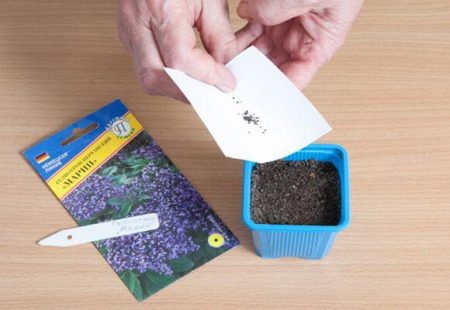
Sowing seeds for seedlings.
- Sowing heliotrope for seedlings should be carried out from the end of February to March 10.
- The soil for sowing is prepared from peat and sand (4:1).
- Before use, it must be disinfected, for example, calcined or spilled with phytosporin. This will eliminate the possibility of seed contamination by various fungal infections.
- The prepared soil is filled into a container or seedling box for sowing seeds and lightly compacted.
- The seeds are evenly distributed over the surface of the soil, and then lightly sprinkled with earth or sand, a maximum layer of 2 mm.
- The container or any container with crops must be covered with glass or film and placed in a warm place with a temperature of +15 to +20 degrees. Seeds germinate in 2-3 weeks.
You can speed up this process soaking seeds in a zircon solution (3 drops in 100 ml of water at room temperature) for 14 hours. This will increase the resistance of seedlings to unfavorable conditions. Seeds treated with zircon will germinate within 4-7 days after sowing.
- After the seedlings emerge, you need to remove the glass from the seedling box and move the box to a lighted place.
- The temperature is raised to +20 - +24 degrees. The seedlings should be protected from the bright sun.
- Caring for seedlings involves moderately moistening the soil.
- Seedlings are picked when two true leaves appear on the seedlings. Pots for picking are used with a diameter of at least 10 cm.
- When transplanting, the seedlings are buried down to the cotyledon leaves and watered.
- 10-14 days after picking, it is necessary to fertilize the seedlings. Ideal or Effecton fertilizer is used as fertilizing.
Planting seedlings in open ground
Heliotrope seedlings should be transplanted into open ground in early June, when the likelihood of morning frosts has passed. The place for planting seedlings should be sunny, and the soil should be loose, well-permeable to water, nutritious, and containing leaf humus.
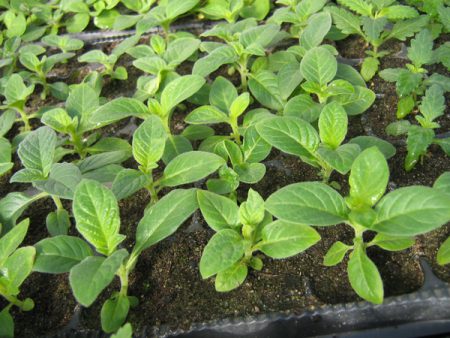
Heliotrope seedlings before planting in the ground.
It is important to avoid planting heliotrope in soil with close groundwater.
Planting seedlings in the ground consists of several steps:
- Preparing holes for seedlings. The earthen ball must fit completely into the planting hole. If the seedlings are in peat pots, then the size of the seedling hole should be slightly larger than the size of the peat pot. Leaf humus is poured into the bottom of the hole.
- The holes for planting seedlings are placed at a distance of 20-25 cm, since heliotrope bushes heavily.Seedlings are planted in prepared holes using the transshipment method, avoiding damage to the roots.
- Cover the seedlings with soil and compact it slightly around the plant. After planting, the seedlings are watered abundantly and the tops are pinched.
Heliotrope blooms in July and continues until frost.
Propagation by cuttings
Cuttings for propagating heliotrope must be taken from an adult plant. To do this, you need to preserve the mother bush until spring. In the fall, a strong, branched specimen is selected, carefully dug up and transplanted into a pot.
Before transplanting, it is useful to spray the plant with Epin-extra solution, and then water it with humate for better rooting of the bush. To reduce stress from replanting, cut off the inflorescences and some of the leaves.
In the room where the transplanted heliotrope will be kept, maintain a temperature of +8-+15 degrees and provide additional lighting. At higher temperatures or with a lack of light, the shoots will stretch out, be weak and are unlikely to survive future rooting.
Therefore, it is better to place the plant on a sunny but cool windowsill. In winter, watering should be moderate. If the leaves of the mother plant fall off, watering should be replaced by spraying.
By observing these simple requirements, by spring heliotrope will produce good, strong cuttings for future plantings.
In March-April you can start harvesting cuttings:
- The cuttings are cut so that each has 3-4 internodes.
- All leaves except the top 1-2 are removed from the cuttings.
- Next, the cuttings are placed in a root former solution for several hours.
- A soil mixture consisting of peat soil and sand 1:1 is poured into mini-greenhouses with good drainage.
- The soil is watered with phytosporin to prevent fungal diseases.The greenhouse must be ventilated periodically.
The temperature favorable for rooting is +25 degrees. Spraying and watering under the root with a solution of the Zircon preparation promotes rapid rooting.
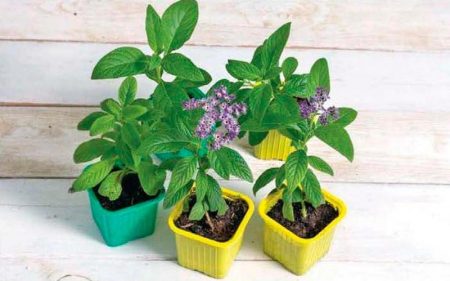
It’s time to plant the rooted cuttings in the ground.
After 3 weeks, the cuttings should take root, this will be indicated by the newly appeared leaves. After rooting, the cuttings are transplanted into separate pots. At first, the seedlings are kept in the shade and the soil is kept moderately moist.
Planting cuttings in the ground
In June, when the threat of morning frosts disappears, it is time to transplant the cuttings into open ground. To stimulate the appearance of new shoots, the tops of the plants are pinched. Heliotrope seedlings are placed at a distance of at least 20-25 cm from each other. It is advisable to protect the plant from strong winds.
Caring for heliotrope in the garden
In order for the plant to grow normally and bloom profusely, proper care is needed. You can care for seedlings grown from seeds and seedlings obtained from cuttings according to the same scheme. Attention should be paid to watering, loosening and fertilizing.
Watering
Heliotrope is a moisture-loving plant. The soil around the plant should always be moist, but heliotrope does not tolerate stagnation of moisture. You need to focus on the condition of the soil. If the top layer of soil has dried out by 2-3 cm, then it’s time to water. On hot days, it is necessary to increase the air humidity around the plant by spraying. This should be done with warm water in the early morning and late evening.
Loosening and mulching
After watering, the soil between flowers should be loosened, combining this procedure with weeding.
The mulching procedure allows you to reduce the number of loosening and watering.
Top dressing
After planting seedlings in open ground, fertilizing should be carried out every 10-14 days.For this purpose, universal fertilizers in liquid form, such as Ideal or Kemira Lux, are suitable.
How to collect seeds and is it worth it?
Growing heliotrope from seeds collected from your own plants in mid-latitudes presents several challenges.
- The seeds do not have time to ripen and their germination rate is poor.
- Seeds that have ripened and managed to be collected have a longer development cycle than purchased seeds.
- Heliotropes grown from their own seeds begin to bloom only towards the end of summer, while the bushes grow different in height and the inflorescences are small.
Wintering plants in the house
To extend the life of your favorite plant after the onset of cold weather, you can transplant it into a pot and place it at home. For comfortable conditions for flower growth at home, it is necessary to organize additional artificial lighting and a certain temperature regime. The pot should be placed on a sunny windowsill.
In winter, heliotrope prefers a temperature of +15-+18 degrees and moderate watering. A glazed balcony is suitable for wintering. In spring, the flower can be planted in the garden again, and if desired, cuttings can be cut and rooted.
Diseases and pests
The main pests of heliotrope are aphids, whiteflies and spider mites.
Signs of the appearance of insect pests will be drying out of young shoots, curling and falling of leaves.
Fighting methods. Treatment with insecticides such as Actellik, Fufanon, which must be repeated after 10 days.
Of the diseases, gray rot is a danger to heliotrope. This fungal disease develops on a weakened plant as a result of improper care. Methods of struggle. It is necessary to treat with fungicides.
What plants does it go with?
Bright heliotrope flowers from July to frost can decorate any flower bed.This versatile flower is used in garden areas to decorate flower beds and flower beds, in borders and as a background plant in multi-level compositions. It can be planted in flowerpots or containers.
Heliotrope goes well with shrubs and flowers that have light green, silver or variegated foliage, with many creeping crops, with plants such as:
| salvia astilbe begonia |
pelargonium petunia coreopsis |
rudbeckia Tagetes coleus |
Purple and blue flowers look especially good on a plain green lawn. By shaping the plant in a certain way during the growth process, you can give it a shrub or standard form.
To obtain a standard form, the trunk of the plant is tied to a support, the upper shoots are pinched at a height of about 50 cm, and all the side branches are removed from the bottom at a length of 30 cm.
Popular varieties
Breeders have bred about 260 species of heliotrope. The most common types:
- European,
- corymbose,
- Kurasawa,
- stem-encompassing.
But the most popular in ornamental gardening is Peruvian heliotrope, also known as tree heliotrope. The Peruvian species is attractive for its long and lush flowering. The most popular hybrids of the Marin series are:
Marine Blue. The height of the bushes is 45 cm. It is distinguished by its lush inflorescences with purple flowers. The aroma of this variety is reminiscent of cherries or cherry pie.
Mini Marine. A low-growing variety with a height of 20-25 cm. It is characterized by dark green leaves with an original purple tint and dark blue flowers. It has a long flowering period and an amazing aroma.
Black Beauty. Height 30-40 cm. Characterized by a bright vanilla aroma and deep purple color.
Dwarf Marin. Height is up to 35 cm, and the color is bright blue.
White Lady. It has pink buds and white flowers. The bush is very compact, spherical, about 40 cm high.
Baby Blue. A young hybrid variety with a blue-violet color and a strong aroma.
Princess Marin. Height up to 30 cm. Has a faint aroma. The inflorescences are large.
Having once decided to plant heliotrope in his garden plot, not a single gardener will regret it later. And the minor difficulties associated with the propagation and cultivation of heliotrope in open ground fade away at the sight of lush blue-lilac inflorescences exuding a memorable aroma.
Continuation of the topic:
- Growing annual dahlias from seeds
- Growing garden balsam
- Planting and caring for Echinacea
- Delphinium - cultivation and care
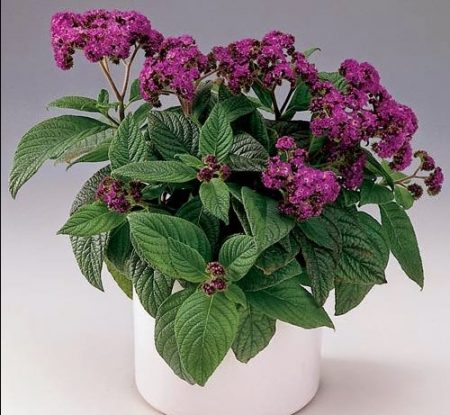
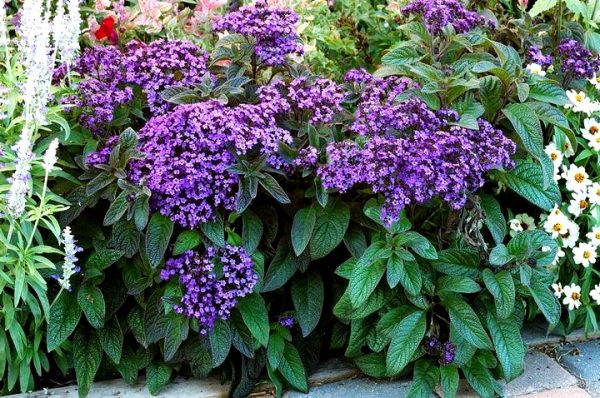
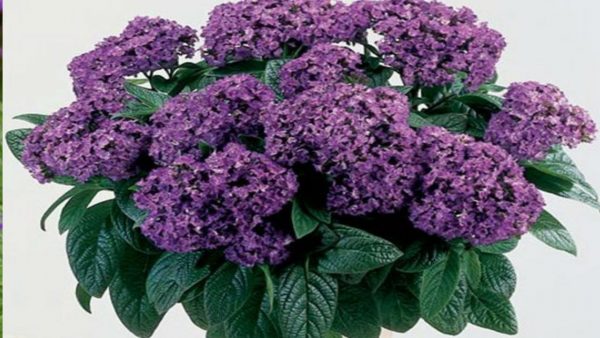

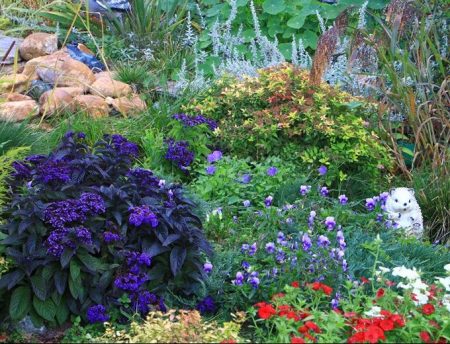
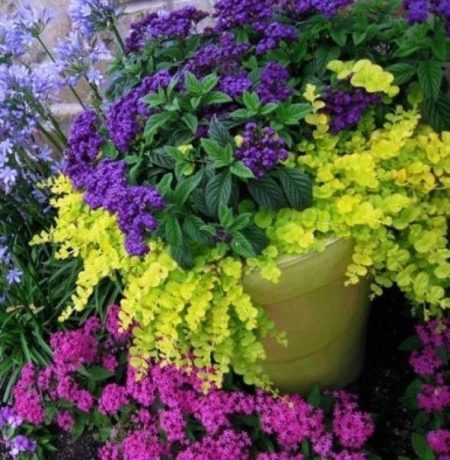
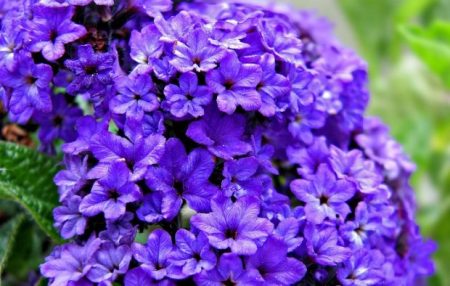
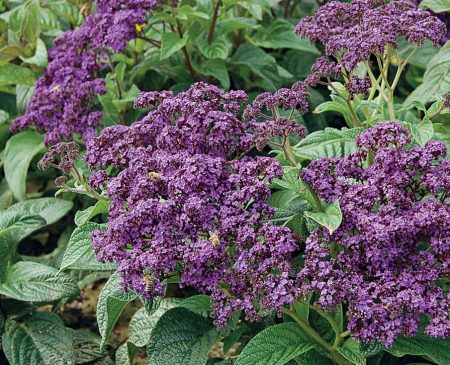
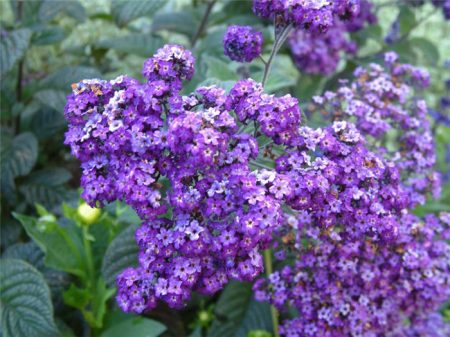
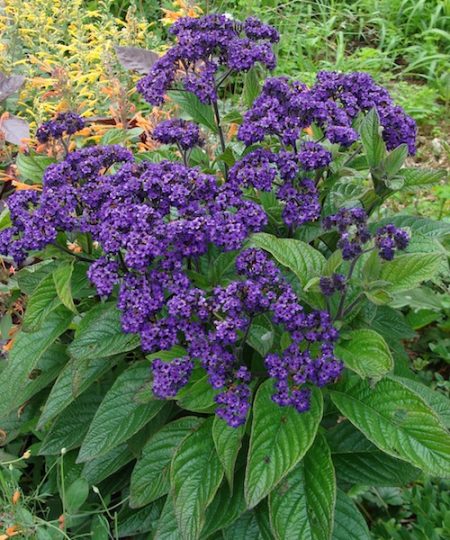

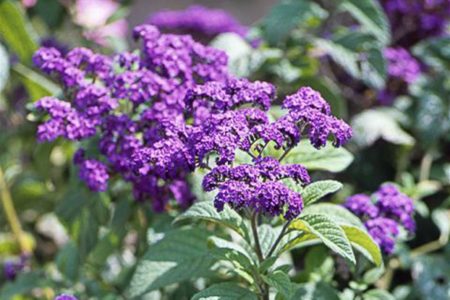
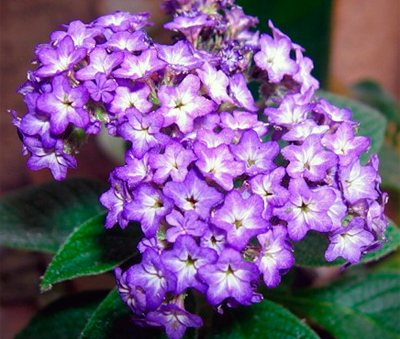

 (5 ratings, average: 4,60 out of 5)
(5 ratings, average: 4,60 out of 5) CUCUMBERS NEVER GET SICK, I'VE BEEN USING ONLY THIS FOR 40 YEARS! I SHARE A SECRET WITH YOU, CUCUMBERS ARE LIKE THE PICTURE!
CUCUMBERS NEVER GET SICK, I'VE BEEN USING ONLY THIS FOR 40 YEARS! I SHARE A SECRET WITH YOU, CUCUMBERS ARE LIKE THE PICTURE! You can dig a bucket of potatoes from each bush. Do you think these are fairy tales? Watch the video
You can dig a bucket of potatoes from each bush. Do you think these are fairy tales? Watch the video
 How our fellow gardeners work in Korea. There is a lot to learn and just fun to watch.
How our fellow gardeners work in Korea. There is a lot to learn and just fun to watch. Eye trainer.The author claims that with daily viewing, vision is restored. They don't charge money for views.
Eye trainer.The author claims that with daily viewing, vision is restored. They don't charge money for views. A 3-ingredient cake recipe in 30 minutes is better than Napoleon. Simple and very tasty.
A 3-ingredient cake recipe in 30 minutes is better than Napoleon. Simple and very tasty. Therapeutic exercises for cervical osteochondrosis. A complete set of exercises.
Therapeutic exercises for cervical osteochondrosis. A complete set of exercises. Which indoor plants match your zodiac sign?
Which indoor plants match your zodiac sign? What about them? Excursion to German dachas.
What about them? Excursion to German dachas.